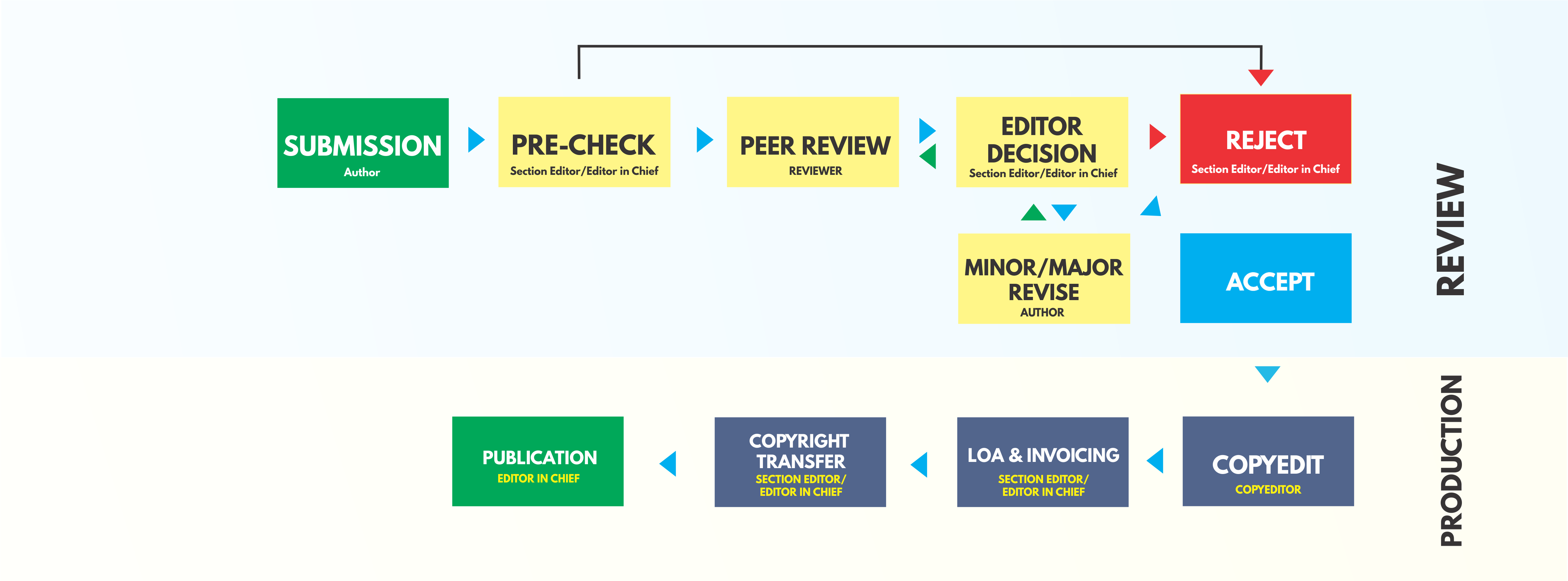Author Guideliness
Cakrawala: Jurnal Pendidikan operates a rigorous and transparent peer-review process that aims to maximize quality. Peer-review is handled by researchers and scholars.
We believe that peer-review needs to be efficient, rigorous, and fair for everyone involved.
In most Cakrawala: Jurnal Pendidikan journals, peer-review is a Double-blind assessment with at least two independent reviewers, followed by a final acceptance/rejection decision by the Editor-in-Chief, or another academic editor approved by the Editor-in-Chief. The Editor-in-Chief is responsible for the academic quality of the publication process, including acceptance decisions, approval of Guest Editors and Special Issue topics, and appointing new Editorial Board members.
HOW TO SUBMIT IN THIS JOURNAL
MANUSCRIPT FLOW
A summary of the editorial process is given in the flowchart below.

NOTE:
- The editor performs the first evaluation in the form of article topic, novelty, article layout, and article originality. If the article is out of the scope and/or has a high plagiarism level, then the article will be rejected. This process can take up to 3 weeks.
- The editor assigns at least 1 Peer-reviewer(s) based on the article topic.
- Peer-reviewer(s) of Cakrawala: Jurnal Pendidikan review the article. This process can take up to 2 months.
- Peer-reviewer(s) submit the review to the Editor.
- The editor performs the second evaluation (related to the revised article based on the reviewer's suggestions) and provides a decision regarding the reviewer's recommendations. The decision can be: accepted without revision, minor revision, major revision, or rejected.
- The author(s) revise the manuscript based on the suggestion from the Peer-reviewers before the deadline. If the submission of the revised article exceeds the given time, the manuscript will be treated like "resubmit for review" or "major revisions and need to be reviewed" (back to step 6). If the Author has been given second chance to revise but does not revise the article until the deadline, the Editor will consider changing the decision by rejecting the article for publication at Cakrawala: Jurnal Pendidikan
- After performing the second evaluation, the Editor will ask the Author to recheck the article layout (based on the Cakrawala:Jurnal Pendidikan’s template) and self-proofread (checking on grammar and typos). Author(s) are given the time up to 2 weeks to perform the checks. Note that any significant modification of the manuscript is only allowed if they are connected with the layout and proofreading. This stage is the final opportunity of the Author to make changes to the Article.
- Editor assigns Proofreader.
- The proofreader reviews the readability of the article. This process can take up to 2 weeks.
- The editor provides proofreading result to the author.
- After Proofreading process is complete, the Editor will perform third evaluation (related to layout and proofreading). This process can take up to 3 weeks.
GUIDELINES FOR CAKRAWALA: JURNAL PENDIDIKAN WRITING ARTICLES
The Author may to submit the paper in two form: Indonesian Paper, or English Paper. We suggest the author to submit it in English Paper.
Download Template here
- Articles in the form of research or the result of thinking about education research that has not been published in other media.
- The article is written in Indonesian or English form of typing, along with a CD recording a maximum of 18 pages, A4, including tables and figures, spaced 1,5.
- Digest abstract or not more than 200 words with 3-5 keywords (keywords) .
Writing structured as follows:
- Accompanied Title author's identity and address of the institution / agency writer.
- Followed abstract keywords, a summary of the article contents as outlined in a solid and not a comment or foreword author, containing the problem, objectives, methodology, findings or research contributions, written in English.
- Introduction: Load background, problem formulation, purpose, usefulness and theoretical framework of the study.
- Methods: should be described 1) review of related theories 2) the type and design of the study, 3) time and location of research, 4) target and research subject, 5) research procedure, 6) the research instrument with determining the validity and reliability and data collection techniques, and 6) techniques data processing and analysis. It is not stated in subtitle but compile it into one pharagraph
- Results and Discussion: All the problems should be no limits.Discussion on problems formulated in the introductory chapter should be clearly defined, systematic, and thorough. Discussion must be compared with previous study and show the academic additional value on it.
- Conclusions : Contains conclusions and suggestions.
References should be written by Mendeley or Zotero with References Style APA 6 Style. The reference must be minumum 18 reference. It according to the literature referenced in the article. So that referred to in the article should be written in the bibliography. Similarly, existing in the bibliography must be referred to in the article.Example Writing Bibliography library materials in the form of books written by the author's name, year of publication, title of book in italics, city of publication, and publisher.To separate the parts used a dot (.), Except between the city and the publisher used a colon (:).
Example
a. From Text Book:
Gronlund, N.E. & Linn, R.L. (1990). Measurement and evaluation in teaching. (6thed.). New York: Macmillan.
b. From Book Chapter:
Effendi, S. (1982). Unsur-unsur penelitian ilmiah. Dalam Masri Singarimbun (Ed.). Metode penelitian survei. Jakarta: LP3ES.
c. From Translation Book:
Daniel, W.W. (1980). Statistika nonparametrik terapan. (Terjemahan Tri Kuntjoro). Jakarta : Gramedia.
d. From final project/thesis/dissertation:
Suyanto, S (2009). Keberhasilan sekolah dalam ujian nasional ditinjau dari organisasi belajar. Disertasi, tidak dipublikasikan. Universitas Negeri Jakarta.
e. From Journal:
Pritchard, P.E. (1992). Studies on the bread-improving mechanism of fungal alpha-amylase. Journal of Biological Education, 26 (1), 14-17.
f. From proceeding:
Paidi. (2008). Urgensi pengembangan kemam-puan pemecahan masalah dan metakog-nitif siswa SMA melalui pembelajaran biologi. Prosiding, Seminar dan Musyawarah Nasional MIPA yang diselenggarakan oleh FMIPA UNY, tanggal 30 Mei 2008. Yogyakarta: Universitas Negeri Yogyakarta.
g. From internet:
Rahmawati, U., & Suryanto, S. (2014). Pengembangan model pembelajaran matematika berbasis masalah untuk siswa SMP. Jurnal Riset Pendidikan Matematika, 1(1), 88-97. Retrieved from http://journal.uny.ac.id/index.php/jrpm/article/view/2667
